Recent Articles
Popular Makes
Body Types
Mercedes-Benz C-Class Used Car Buyer’s Guide
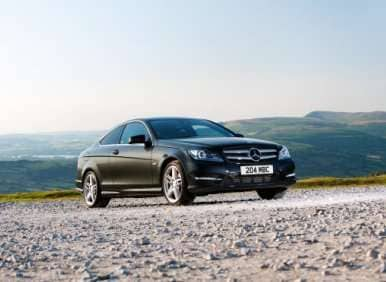
The entry-level model Mercedes-Benz in the United States, the C-Class nevertheless exudes refinement, good performance, and prestige. On the road, the car feels every bit the Mercedes-Benz it is. With solid road manners, exceptional speed for its size, and considerable comfort (for front-seat passengers).
Instantly recognizable as a Mercedes-Benz product, the C-Class is a good way to drive a Benz on something of a budget. Be aware however, when it comes to maintenance costs, mechanics do not differentiate between the C-Class and the S-Class. The shop’s hourly rate is the same across the board. This is also true for parts costs. As all of the switchgear used by all MBZ products comes essentially from the same parts bin, so—as the saying goes—“parts is parts”.
Of course, the other side of that equation is the C-Class also feels largely like every other Benz going down the street. Initially introduced in 1994, as a replacement for the 190E, there have been three generations of the C-Class offered to date. This retrospective picks up with the second generation Mercedes-Benz C-Class introduced in 2000, as a 2001 model.
Mercedes-Benz C-Class Used Car Buyer’s Guide: 2001 – 2007
Smaller and more lithe than the model it replaced, the second generation of the Mercedes-Benz C-Class was considerably more athletic than the previous car built from 1994 – 2000. Where that model was staid and upright, the new one was sleek and sporty.
Two engine choices were initially offered at the launch of the W203 (Mercedes’ internal code designation for the car). The base engine was a 2.6-liter V6, producing 168 hp and 177 foot-pounds of torque. The larger engine was a 3.2-liter V6, capable of generating 215 hp and 221 foot-pounds of torque. For the first time in the history of the C-Class in the United States, a six-speed manual transmission was offered as standard equipment. The manual transmission was fitted to the 2.6-liter engine, a five-speed automatic was optional. Meanwhile, the five-speed shiftable automatic was the only transmission offering with the 3.2.
Contrary to conventional MBZ logic, the 2.6-liter engine was installed in a model designated C240, while the 3.2 resided in a model designated C320. Both the C240 and the C320 were rear-drive automobiles, although an all-wheel drive variant of the C-Class would appear in model year 2003.
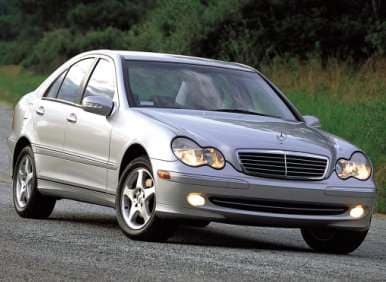
Mercedes-Benz C-Class Used Car Buyer’s Guide: 2001
While it was the entry level Mercedes model in the U.S. at the time, the C-Class was every bit a Mercedes-Benz and thus came rather nicely equipped. The base C240 model featured—as standard equipment; 16–inch alloy wheels, variable intermittent windshield wipers, a rear window defogger, height adjustable four-way power adjustable front seats upholstered in leather, and a folding rear seat back with storage in the center armrest.
All four power windows featured one-touch operation. The power door locks could be operated remotely. The electrochromatic inside rearview mirror dimmed automatically, while the outside rear view mirrors featured turn signal repeaters, in addition to being heated and power adjustable. The passenger side rear view mirror would also tilt to provide curb views when the vehicle was reversed.
The front console incorporated storage, there were front and rear cup holders, front and rear door pockets, storage in the front seat backs, cruise control, and the tilt and telescopic steering wheel featured audio controls in addition to operating a power steering rack.
There was also a universal remote transmitter for garage doors, security systems, and etc., a 12V front power outlet, and cruise control. The dual-zone climate control system featured interior air filtration, extended cabin heating, and ducts for the rear of the passenger compartment.
There was wood trim on the center console, dashboard, and doors. The instrument panel featured a clock, a tachometer, a trip computer, and an external temperature display. Leather was used to trim the shift knob and the steering wheel. There were also front reading lights and front and rear floor mats.
The audio system used seven speakers and an AM/FM stereo head unit.
A navigation system was optional, as was Mercedes’ Cockpit Management and Data System (AKA COMAND). Its center console-mounted dial operated an interface that would control the navigation system, audio system and cell phone functions.
Other options included Xenon headlights, heated seats and a six-disc CD changer. There was also a Sport package offering to improve the C-Class cars’ handling with higher spring rates, tighter shock valving, a thicker stabilizer bar, and larger tires.
The 2001 Mercedes-Benz C-Class safety and security package included four disc brakes with ABS, electronic brake force distribution, emergency braking assist, stability control, traction control, and an engine immobilizer. There were also front and rear head airbags, dual front and will rear side mounted airbags, child seat anchors, and front seatbelt pre-tensioners. The C240 also featured fog lights; dusk sensing headlamps, daytime running lights, a remote antitheft alarm system, turn signal repeaters in the exterior mirrors, and an emergency interior trunk release.
The C320 featured all of the same equipment, plus; eight-way power adjustable seats for the driver and front passenger, memorized settings for the steering wheel position and the climate control system, dual illuminating vanity mirrors, and a 10-speaker Bose audio system.
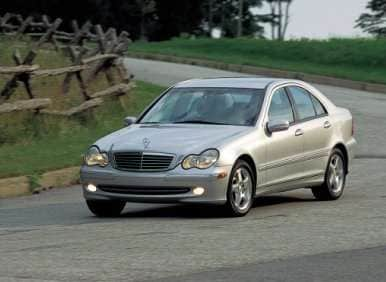
Mercedes-Benz C-Class Used Car Buyer’s Guide: 2002
For model year 2002, Mercedes-Benz introduced a hatchback, a wagon, and a high-performance sport sedan version of the C-Class. The hatchback was called the C230 Kompressor Sport Coupe; the wagon was designated C320 wagon, while the high-performance version was called C32 AMG.
A 192 hp 2.3L in-line four-cylinder engine with a supercharger powered the C230 Kompressor Sport Coupe. This powerplant was capable of producing 200 foot-pounds of torque. A six-speed manual transmission fed the rear wheels of the hatchback baby Benz.
Standard equipment included a dual-zone climate control system, aluminum cabin trim accents, 16-inch alloy wheels, a six-speaker sound system with an audio cassette deck (a CD changer was optional), a tilt and telescopic steering wheel with both audio and trip computer controls, and an eight-way manually adjustable driver seat.
Leather upholstery, in addition to a Panorama sunroof were options.
On the safety front, the C230 Kompressor sported four-wheel disc brakes with ABS and Brake Assist, along with electronic stability control, plus side and head-protection airbags.
The 2002 Mercedes-Benz C320 Sport Wagon was equipped largely the same as the 2001 C320 sedan.
The C32 AMG on the other hand, was an entirely different beast altogether. This model rocked a 349 horsepower supercharged version of the C320’s 3.2-liter V6. An aggressively programmed five-speed automatic transmission called "SpeedShift" by the marketing team at Mercedes-Benz routed that power to the rear wheels. The c32 AMG was said to be capable of screaming to 60 mph in around 5 seconds flat.
To keep all of that in check, the engineering team at AMG prescribed a larger set of vented disc brakes, an even more aggressive AMG-massaged suspension than the standard sport package provided, with 17-inch alloy wheels holding fat high-performance low profile tires.
To further differentiate the model, a front air dam and side skirts, a unique set of wheels and a two-tone interior partition the C32 from the more prosaic C-Class sedans.
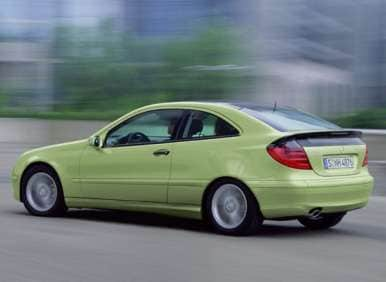
Mercedes-Benz C-Class Used Car Buyer’s Guide: 2003
All-wheel drive was added to the lineup for the sedans and wagons running the normally aspirated engines (in other words for everything except the C230 Kompressor and the C32 AMG). The C320 got a six-speed manual option and the supercharged 2.3-liter engine was also fitted to the sedan.
To improve the handling and braking of the C230 Kompressor Sport Coupe, 17-inch wheels and high performance tires were specified. The model also got a three-spoke fat-rimmed sport steering wheel, a leather-wrapped gearshift knob, an aluminum pedal set, and a larger chromed exhaust outlet than the standard car used.
These upgrades were also applied to C-Class Sport sedans, along with new four-piston calipers for the front brakes and drilled rotors. Increasing the performance quotient were a sport shift manually operable transmission, a lowered sport suspension system, a free-flow exhaust system, and a set of all-new five-spoke alloy wheels.
C-Class models were formally divided into Sport and Luxury models for MY’05. Basically, the Sport Package became a trim line unto itself. When cars were not equipped with it, they took on the designation “Luxury”. (C320 vs. C320 Luxury for example.)
The C55 AMG replaced the C32 AMG. For the C55, the AMG team fitted a normally aspirated 5.4-liter V8 to the C-Class, one capable of generating 362 hp and 376 foot-pounds of torque. The engine was paired with a five-speed automatic manually shiftable automatic transmission.
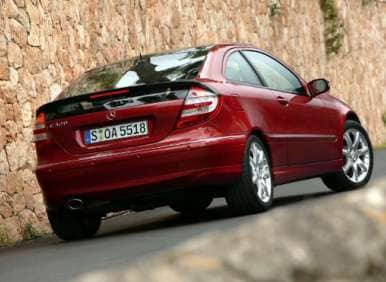
Mercedes-Benz C-Class Used Car Buyer’s Guide: 2006
The wagon and the C230 Kompressor Sport Coupe were dropped. Four-cylinder engines were also relieved of duty in favor of a set of new V6 engines. And, to round out the powertrain changes, two new transmissions were fitted, a five-speed for the all-wheel drive (4Matic–in Mercedes-speak) cars, and a seven-speed automatic for all the rest (except the C55).
So, for 2006, the Mercedes-Benz C-Class was offered as the C230 and C350 Sport Sedans, C280 and C350 Luxury Sedans, and the C55 AMG.
Standard equipment for the C230 Sport Sedan was a 201hp/181 foot-pound, 2.5-liter V6, 17-inch wheels, a sport-tuned suspension system, cloth-upholstered sport seats, a dual-zone climate control system, and an AM/FM/CD-based head unit for the stereo audio system.
The C280 luxury sedan offered all of the above plus, a 228-hp/221 foot-pound, 3.0-liter V6, along with 16-inch wheels, suspension tuning geared more for a smooth ride than sharp handling, a choice of leather and cloth seating, and genuine wood interior accent trim.
The 2006 Mercedes-Benz C350 Luxury Sedan was equipped like the C280, but with a 268hp/258 foot-pound 3.5-liter V6, and a pair of 10-way power-adjustable seats with memory.
The C350 Sport Sedan added 17-inch wheels, a firmer suspension system for better handling and deeply bolstered sport seats to the C350 Luxury.
The 2006 C-Class options list contained full leather upholstery, Xenon HID headlights, a DVD-based navigation system, a 12-speaker Harman-Kardon Logic 7 sound system, and satellite radio.
The C55 was discontinued.
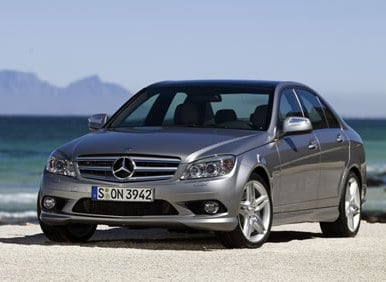
Mercedes-Benz C-Class Used Car Buyer’s Guide: 2008 – 2012 (Current Model)
For the 2008 model year, Mercedes-Benz released an all-new version of the C-Class. The longer wheelbase enabled more interior room, and that larger interior was endowed with more standard features.
Among them were an optional hard drive based nav system, surround sound audio and a simplified interface for the COMAND telematics system. Additionally, the suspension system’s components were lightened to improve both handling and fuel economy. The engines were largely carried over from the previous generation—with one exception.
The 228-hp/221 foot-pound, 3.0-liter V6 engine powering the previous generation’s C280 returned, this time powering a model known as the C300. The 2008 C350 was powered by the same 268hp/258 foot-pound 3.5-liter V6 powering the 2007 C350. The AMG C-Class returned after a one-year hiatus, this time with a 451hp, 6.2-liter V8 engine, and the C63 AMG nomenclature.
The two-trim strategy for each model survived the jump along with the engines. Just as in 2007, Luxury and Sport versions were offered for each model within the range.
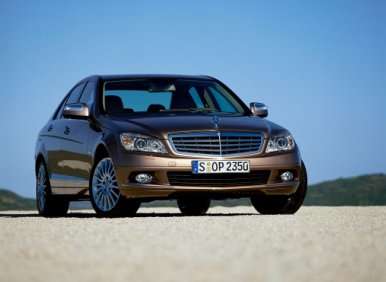
Mercedes-Benz C-Class Used Car Buyer’s Guide: 2008
The entry level W204 C-Class for 2008 was the C300 Sport model. Standard features for this car included 17-inch alloy wheels, variable intermittent windshield wipers, a rear window defogger, and a power glass sunroof capable of remote operation.
The height adjustable eight-way power sport seats for the driver and front passenger, both with manually adjustable lumbar support, were upholstered in leatherette. The rear seat back was capable of folding and featured a center armrest with storage. The power door locks and one-touch windows featured remote operation, and the power adjustable exterior mirrors were heated.
Also included in the base price was cruise control, a cargo net, a front console with storage, front and rear cupholders, front door pockets, front seat back storage pockets, and a first aid kit. There was a remote trunk release and the C-Class retained accessory power when its engine was shut off.
The speed proportional power steering system was controlled by a leather-wrapped tilt and telescopic steering wheel with audio controls. The 2008 C300 Sport also used a six-speed manual transmission with a hill holder function as standard equipment. There were 12V front and rear power outlets, and the dual zone climate control system featured interior air filtration, ventilation ducts for the backseat, and a cooled storage compartment.
There was a trunk light, front and rear reading lights, turn signal repeaters in the exterior mirror housings, and dual illuminating vanity mirrors. Alloy trim accented the center console, dashboard, shift knob, and the doors. The instrument panel contained a clock, a tachometer, a trip computer, an external temperature display, and a low fuel level warning indicator.
The audio system used eight speakers, a 100W amplifier, and an AM/FM in-dash single-disc CD player, which incorporated a CD changer controller with CD MP3 playback capability and an auxiliary input port for a portable audio device. The COMAND control interface used a pop-up display screen, The 20008 C300 sport was pre-wired for a cellular phone and also included a Bluetooth wireless data link for hands-free telephony.
The safety and security suite consisted of four ventilated disc brakes with ABS, electronic brake force distribution, brake drying, and emergency braking assist. There were front and rear head airbags, dual front side mounted airbags, a passenger airbag occupant sensing deactivation system, front and rear seat belt pre-tensioners, a rear center three-point safety belt, and child seat anchors.
The W204 also had a remote antitheft alarm system, an engine immobilizer, daytime running lights, fog lights, automatic off delay and dusk sensing headlights, stability control, and traction control.
The C300 Luxury model was differentiated by dint of its exterior appearance, interior trim, front seat design and its usage of an automatic transmission as standard equipment. The most notable aspect of the exterior differences was the use of the traditional Mercedes radiator grille and the positioning of the three-pointed star on the hood. (Sport models have the star mounted in their grilles.) Inside, the highly bolstered sport seats gave way to more comfort oriented seats and wood trim replaced the alloy trim.
Options were grouped into packages; the Premium I Package added rain-sensing wipers, auto-dimming mirrors, heated front seats, and satellite radio. Because these features were standard equipment on the C350, the C350 Sport is basically the same as a C300 Sport set up with the Premium I Package and black bird's-eye maple wood interior trim.
Both the 300 and the 350 could be optioned out farther though. The bundle of kit known as the Premium II Package added split-folding rear seats, a power rear window sunshade and bi-Xenon HID headlamps.
The Multimedia Package designated for the C-Class endowed the smallest Mercedes with a hard-drive-based navigation system, voice controls and the Harman Kardon surround-sound audio system, which incorporated an in-dash six-disc CD changer.
There were stand-alone options for the W204 as well; these included leather upholstery, a panoramic sunroof, MBZ’s TeleAid satellite communications suite of services, a set of 18-inch wheels, a DVD player, an iPod integration kit and an in-dash CD changer.
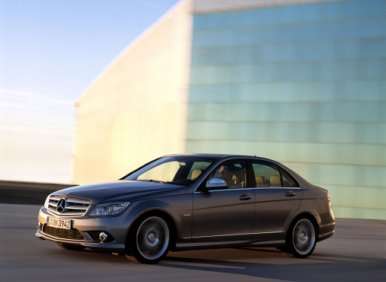
Mercedes-Benz C-Class Used Car Buyer’s Guide: 2009
For model year 2009, the C-Class got a few minor tweaks; the nav system got Zagat restaurant ratings added, along with a 40-Gig hard drive for music storage. The Sport models got a new instrument panel, and pelvic airbags were installed in all iterations of the car.
An active suspension system, a quicker steering rack, steering wheel mounted shift paddles and 18-inch AMG wheels were fitted to the Sport models with rear-wheel drive—if the optional Dynamic Handling package was ordered. A smarter tire pressure monitoring system was fitted, along with sleeker, more aerodynamic exterior mirrors. The leather-wrapped steering wheel was improved as well. The trickle down theory brought a rearview camera, a new iPod interface and keyless entry and start down from the C-Class Mercedes’ more pricey siblings.
The Dynamic Handling package was killed.
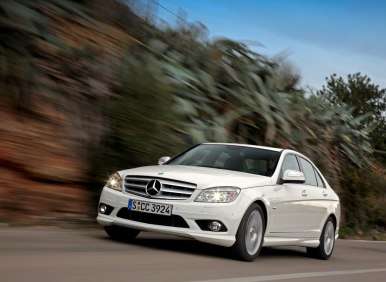
Mercedes-Benz C-Class Used Car Buyer’s Guide: 2012
For 2012, Mercedes-Benz debuted a genuine C-Class coupe, rather than a hatchback. The new C-Coupe was configured identically to its sedan siblings. Additionally, four-cylinder power returned to the C-Class for the first time since the 148-hp C220 of the first generation of the car.
This new one four-cylinder engine was turbocharged and made 201 horsepower and 229 foot-pounds of torque from 1.8-liters. A seven-speed automatic was paired with it. The C350 got a more powerful V6 capable of 302 hp and 273 foot-pounds of torque. The C300 became an all-wheel drive proposition only.
An interior refresh was enacted, along with a mild exterior styling update.
The AMG version of the C-Class Coupe was the biggest story though, thanks to the release of the C63 AMG Black Series coupe. Right off the top, the model got a more powerful version of the C63 AMG’s 6.2-liter V8. This one was capable of 510 hp and 457 foot-pounds of torque.
The engine was supplemented with an adjustable coil-over sport suspension system, high-performance composite disc brakes with ABS at all four corners, additional engine cooling capacity, a rear axle differential lock, a wider track, aerodynamic body modifications, a unique set of 19-inch wheels, a rear air diffuser, a two-sport seat interior (the rear seat was deleted), and microfiber upholstered the seats and the steering wheel. There were also a number of AMG-specific interior design elements.
And yet, there could be still more added to the model; the optional AMG Track package fitted ultra-high-performance tires and an active cooling unit for the rear axle. The AMG Aerodynamics package added exterior airflow management winglets and an adjustable carbon-fiber tail spoiler to the ultimate C-Class Mercedes-Benz.
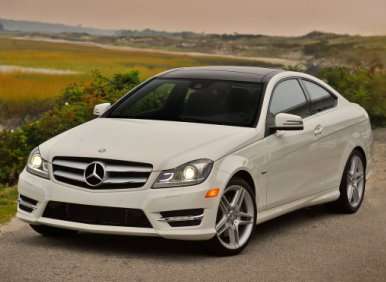
Mercedes-Benz C-Class Used Car Buyer’s Guide: Summary
One of the most versatile cars in the Mercedes lineup, the C-Class can be configured as a rear-drive sport sedan, a rear-drive luxury sedan, a station wagon, an all wheel drive version of all three, and a rear-drive coupe. There are also high-performance models and super-high performance models. Within the ranks of the C-Class Mercedes-Benz there really is something for nearly everyone.
Because of this, the C-Class Mercedes has also been a really good selling model as well. There are thousands of them out there on the secondary market—so the prices are quite reasonable (for what they are). Further, the odds of finding a nice clean driver are quite high. Keep in mind the admonition we offered in the intro though, maintenance on these cars is quite expensive. That three-pointed star commands a price premium. Speaking of premiums, depending upon the model you have your eye on, insurance can be a mite spendy as well. Make sure you get some insurance quotes before you commit to the purchase of any of the AMG models, as these will command the highest tariffs—insurance-wise.
There have been recalls for the baby Benz over the years. The transmission has also been known to give trouble, so you’ll want to spend some time in MBZ forums here on the ‘Net to get an idea of what you’re letting yourself in for. A vehicle history report against the VIN of the two or three cars you finally narrow your search down to will prove beneficial as well.
And, as always, a very thorough inspection by a trusted, professional, independent Mercedes-Benz mechanic could save you a ton of money over the long haul.
Overall, these are pretty reliable cars.
But when they break, it ain’t cheap to put them straight.
